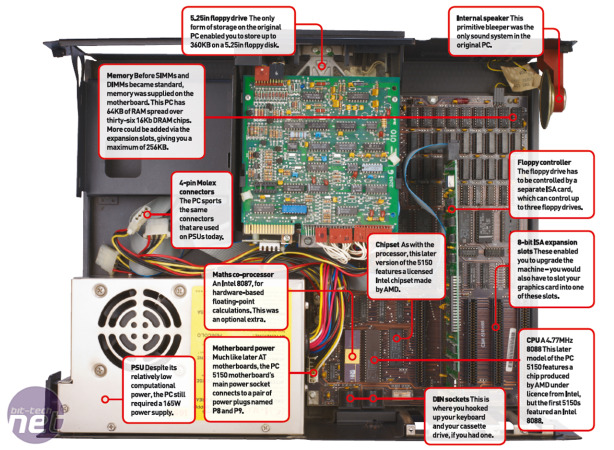IBM PC 5150 Up Close and Personal
The PC 5150 is remarkably primitive compared with modern standards. The machine had just 64KB of RAM as standard, which could be expanded to 256KB via 64KB expansion cards. There was also no hard disk, with storage duties handled by a 5.25in 360KB floppy drive. Meanwhile, depending on your monitor and graphics hardware, you had a choice of a monochrome text-based character display or CGA graphics, the latter of which could display only four colours at a resolution of 320 x 200.Also of note is the processor – a 4.77MHz Intel 8088, along with a socket in which you could install an optional 8087 maths co-processor for hardware floating-point mathematics. The processor was an interesting choice though. The PC architecture has rigidly stuck by Intel’s x86 instruction set ever since, but this could have been very different if IBM had chosen to use another type of processor.
In particular, IBM spent a lot of time developing its own RISC-based processor called the 801. ‘If I remember rightly, the 801 was actually looked at for the 5150, or the follow-on from the 801,’ says Muldoon, ‘but I’m not sure there was a single-chip implementation of the 801 at the time.’
The single-chip design of Intel’s CPUs wasn’t the only feature in their favour though. Remember that IBM had already had experience with the 8085 in the System/23 Datamaster, and the 8086 in the DisplayWriter – a standalone word processor that was 8086-based, with a screen that’s almost identical to a monochrome PC screen, as well as floppy drives, a printer and so on.
Experience with the Intel architecture was a key factor. ‘The original PC is absolutely keyed to the Intel bus and Intel interface,’ explains Muldoon. ‘The address bus, the data bus and the control bus are just extensions of the processor, and IBM already had experience doing that with Intel’s buses with those other two products, so I think that’s why IBM went with Intel for the 5150: experience.’

MSI MPG Velox 100R Chassis Review
October 14 2021 | 15:04










Want to comment? Please log in.